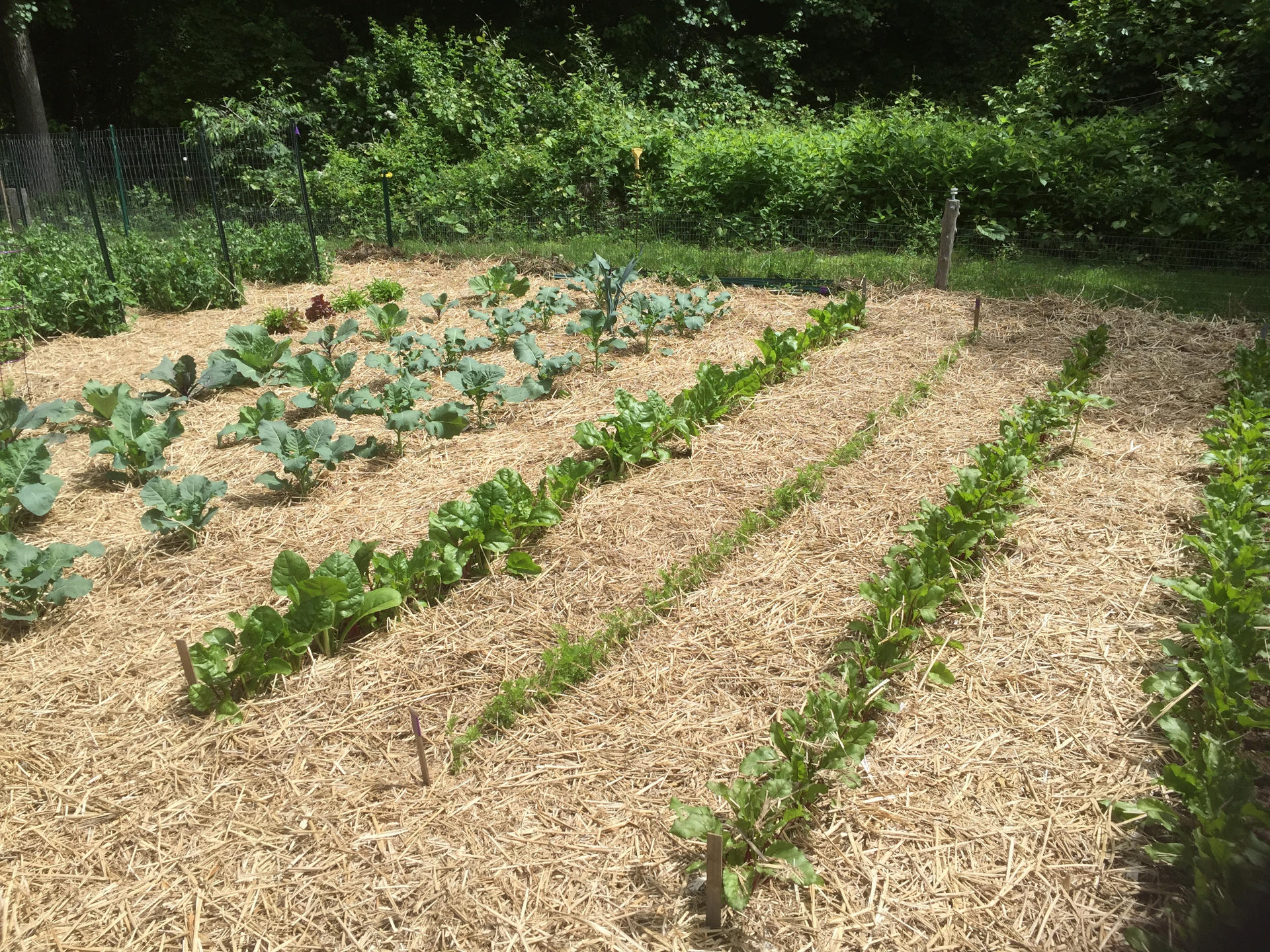
Garden after mulching. Vivian Berry
How Does Your Garden Grow?
A Conversation with Vivian Berry, Cultivator and Steward of Berry FarmZ
By Véronique Firkusny
Sign up for our monthly newsletter!
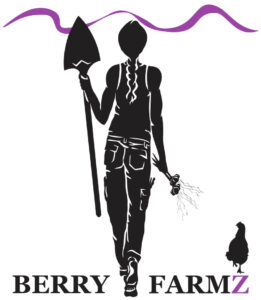
It’s February, the light lingers a little longer, and you decide that you would love to have a spring garden! I turned with this question to Vivian Berry, cultivator and steward of Berry FarmZ. Tucked just off a major thoroughfare in the lower Hudson Valley, the expanse of green nestled behind the house appears as a surprise. It was this open space that captured Vivian’s imagination when she bought the property 25 years ago. Ever since, essentially singlehandedly, although friends and family occasionally stop by to give a hand, she has been shaping the land into the vibrant and nourishing place it has become.
To fortify us for this conversation at the end of January, Vivian cooked up a lunch with ingredients mostly from her garden: a puréed Butternut squash soup, with roasted seeds on the side for a delicious crunch; a quiche with peas; garlic bread; and for dessert, a Chia seed pudding with blueberries and raspberries. The Chia seeds, she explains, are not from her garden, although she did try one year to grow the Salvia hispanica plant they come from, but it needs a longer growing period to produce seeds.
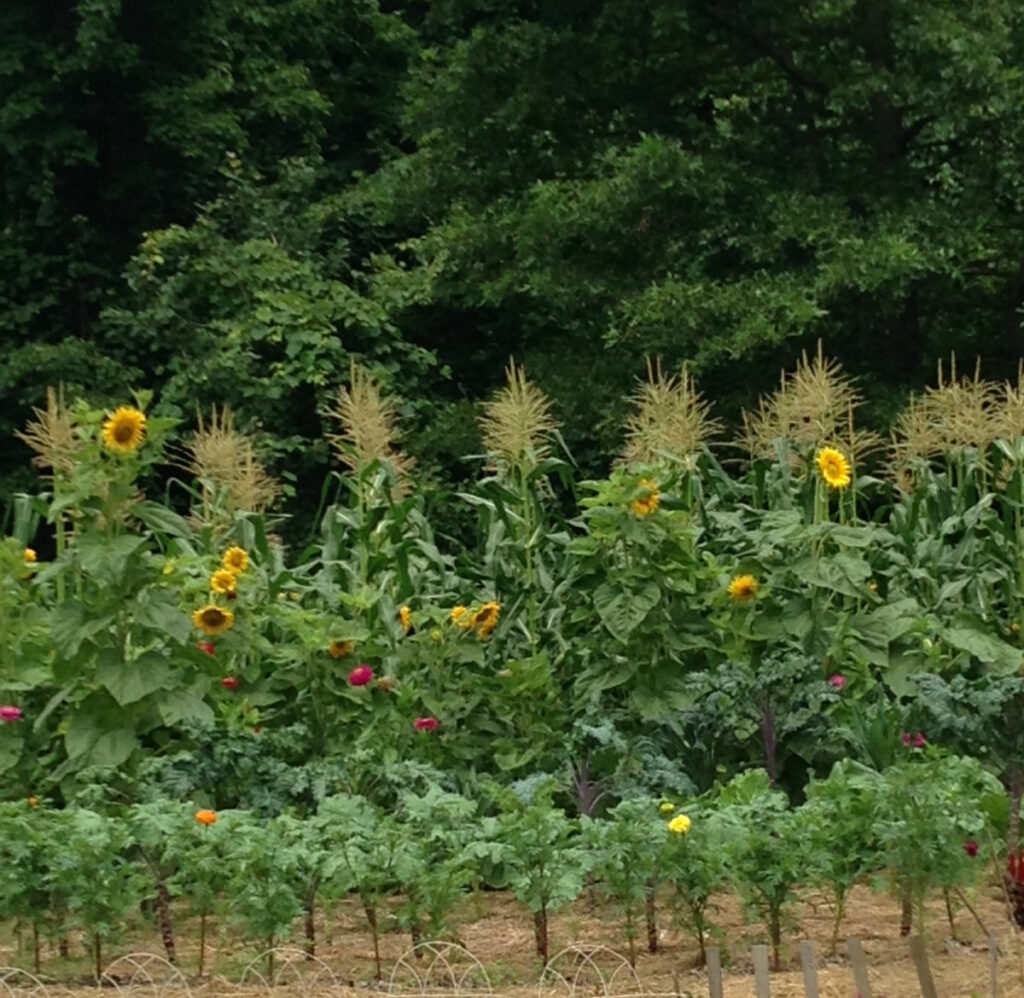
If one is starting from scratch, other than digging up the grass and clearing out the rocks, is there anything special one needs to do to prepare the earth for a garden?
Not really. A virgin garden is probably the best grow you are going to get, when you first start growing in a spot where you’ve never grown anything before. Every year since, I augment the soil with chicken manure and I mulch with hay, so a lot of organic material is in the garden.
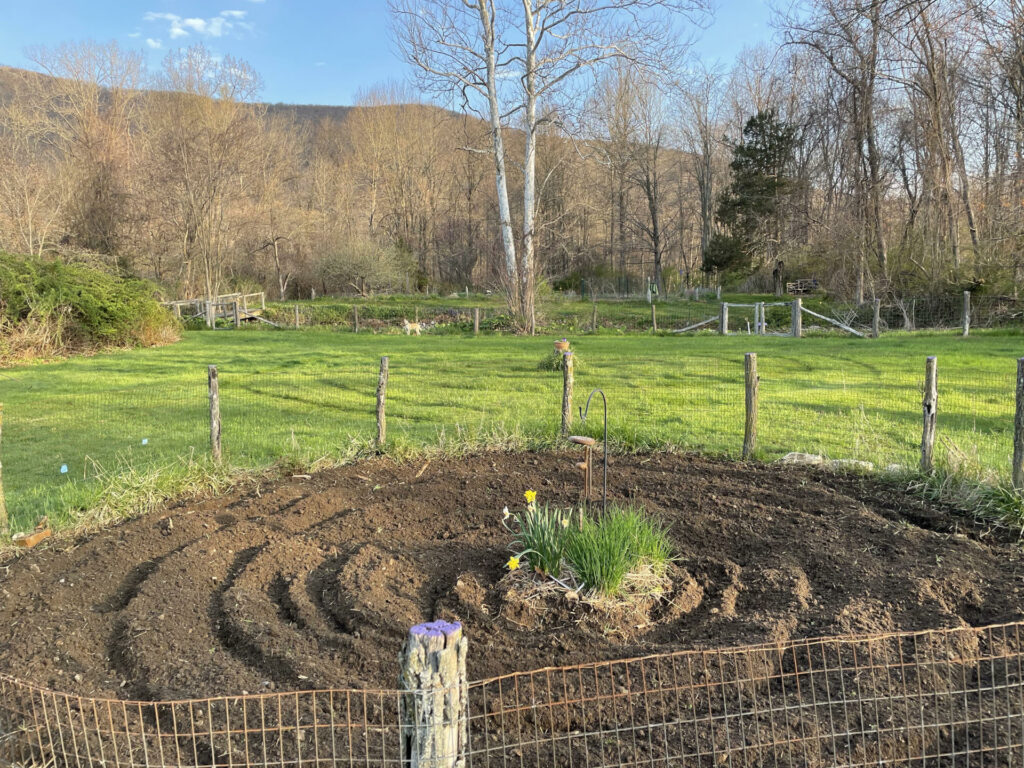
How early does one need to start if one wants a garden in the spring?
Spring gardens can really be started at any time, but you need to have pots big enough to hold all your seedlings. You have to work backwards from when you want to plant, because every climate, every area, is going to be different. So here, it used to be that May 31st was our last frost date but that has changed. Our climactic zone used to be a five, now it’s a six. As the numbers go up, it’s generally warmer. Around here, I can safely plant May 15th, so that’s why I now start my tomatoes in March—it used to be the first of April. My season has shifted two weeks in advance.
There are some things that I prepare in the fall for spring planting, like peas. Peas go into the dirt as soon as it can be worked, so sometimes in March, the dirt is thawed and ready to plant, and peas will germinate when the soil temperature is cold. I prepare the pea trellises and the soil in the section that I determine that year for the pea planting when I plant the garlic in the fall. This way in the spring, it doesn’t matter if we have an early warm spell, I don’t have to race and chase things around.
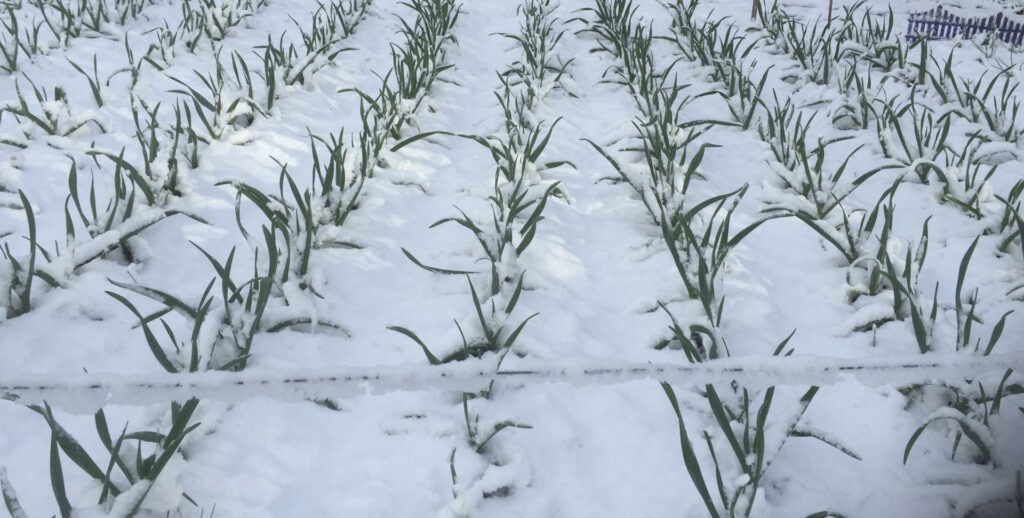
Where do you get your seeds?
I generally order from a company called Fedco in Maine, an excellent company, that lets you order seeds in different sizes. Most companies will sell you a packet of seeds, but Fedco gives you different options, a size A, B or C, depending on the quantity you need. Peas, for instance, I need a lot of seeds, because I’m planting four 15-foot rows. You can be very mathematical about it, I’m more visual, so I look at the plot and estimate how many seeds I think I’ll need. But I have had times where I’ll only have ninety seeds, and I want to plant them all, and I want to plant them most effectively in terms of being efficient with space. So then you divide—the seeds need to be 2 inches apart, you have a ten-foot row—and you do the math.
Do you ever get seeds from local seed banks?
My cousin is involved with the library in Tarrytown, NY, and they have a seed exchange program where people bring in their excess seeds. Then they put them in kind of a card catalogue and people can go in and take out seeds, so it’s kind of a cool thing for a library to do. You do always want to think about where the seed comes from.
Do you ever plant wild seeds?
Not really, but I will sometimes dig up a plant and transplant it.
Can you describe your technique for seed processing and storage?
I try to save seeds from just about everything I grow—lettuce, cilantro, edamame—but here’s the issue I’ve had with edamame over the years: squirrels really like edamame. So, when I leave an edamame plant to grow to full maturity, for the seeds to be viable, the squirrels find them. So I used to save my edamame seeds, but somehow the squirrel population has really increased. Cilantro, which is one of my favorite herbs—I love it when it’s green and leafy—then goes to seed and becomes coriander. I grow tons of it, I let it go to seed, and then I love the green coriander, when it’s just become a seed. I grind that up and use it all the time, and that’s about mid-summer. The rest I leave on the plant and let it dry out, and that becomes my seed for next year. I go into the garden with a paper bag and pull it off, and whatever falls on the ground is fine, because it just reseeds for next year. I keep the seeds in a paper bag or a paper envelope—if there is any moisture, the paper will absorb it.
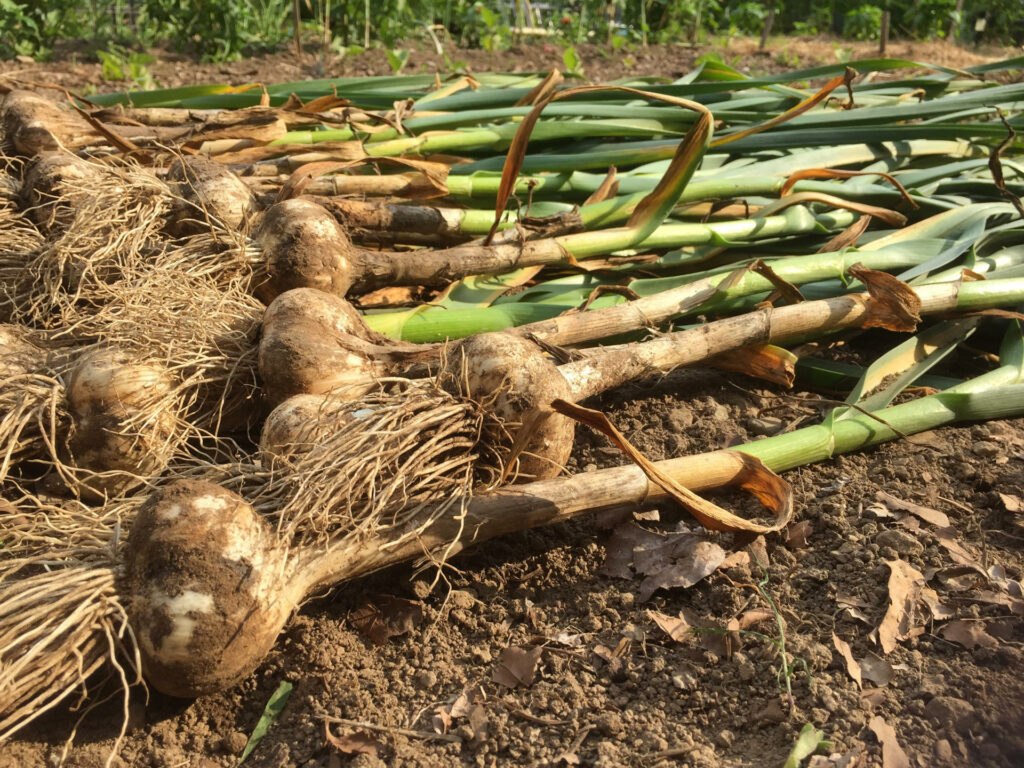
How do you take care of your soil? Any tips on how to nourish your soil? Horse manure?
Before I had chickens, I would go around to various farms collecting manure. Horse manure isn’t the best. I think cow manure is the best, because cows have more than one stomach, so they digest what they eat very well, and you’re not going to have a lot of seed in the manure. One year I borrowed a friend’s truck and went down to a local farm that used to sell cow manure and filled up the whole back of the pickup truck, but the cow manure was fresh, so I had a pile of it right by the street and had to let it sit for a year. Or you can drive around to a bunch of farms, like I did one year with a friend who also loves to garden, and we would just ask if they had any aged cow manure that we could fill a few buckets with, and we were both very happy about it. And there was a year that I got horse manure from a company that has dumpsters and takes away manure from horse farms. Somehow my cousin found a company that would deliver a dumpster full to you, and I got probably around 60 yards of horse manure, because they saw how much space I had—I had them dump it up the road—and they kept coming. That lasted me a few years, because I just wheelbarrowed it back to the garden all the time. When you plant, you can dig a very deep hole, and put the manure in the bottom of the hole, so that when the plant gets big enough to start fruiting, it reaches all those nutrients and fruits better.
And now with your chickens?
Chicken manure is very hot, meaning it’s very, very raw, when it first comes out of the chicken. Very high in nitrogen and uric acid, so using poop that isn’t aged will burn your plants. I have a “manure-tea” bucket that is brewing right now in the basement, that has chicken poop in it, and eggshells from the eggs, ground up into a powder, so that they become a little more easily bio-available in the soil. So I have my manure tea brewing through the winter, and I start feeding the garlic in March. I dilute it, like one cup per gallon of water, and I have a watering can and go out there and start feeding. The manure tea I usually use for plants that are already established or that are coming, because you can foliar feed plants, so that you feed the leaf. I’ll go around the garden about every two weeks and sprinkle over the top of all my plants so that the foliage will absorb all the nutrients. You can feed topically, and you can also feed from underneath, but when you feed from underneath, it’s before you plant.
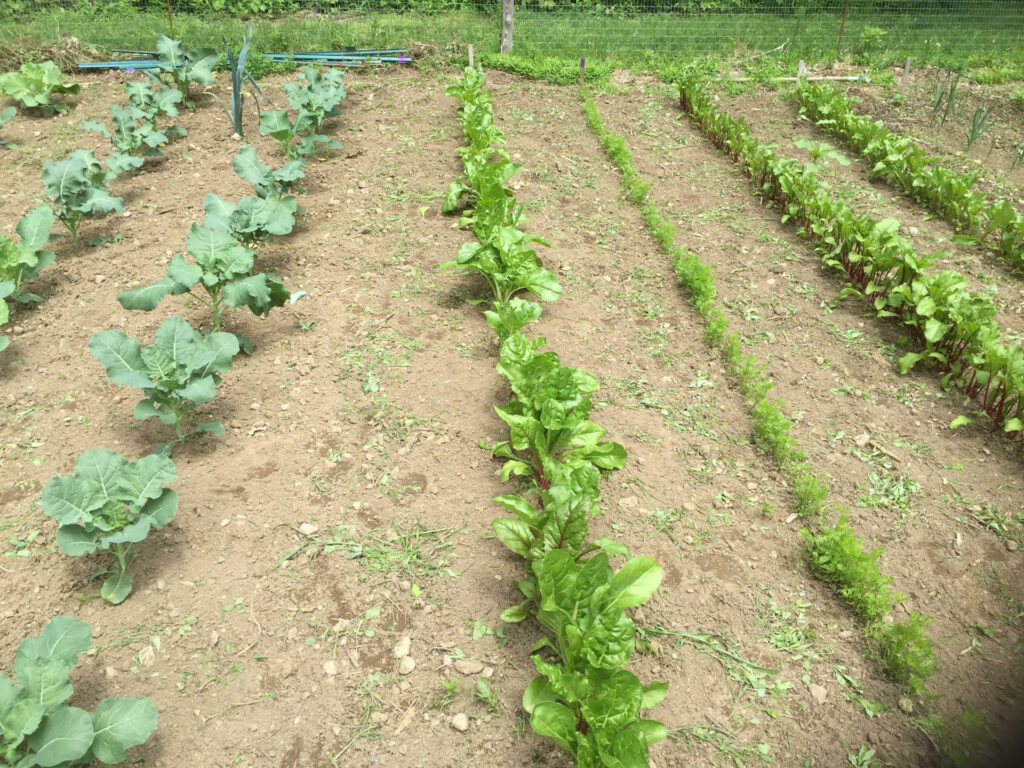
What do you use for natural pest and disease management?
My fingers…. There’s the green cabbage worm that comes from that little white butterfly or moth, and they dance around each other and are very pretty if you don’t know how destructive they can be. But all butterflies and moths lay their eggs generally on vegetation, because they need to lay their eggs where, when they hatch, there is immediately a food source. So, my relationship with butterflies, much as I appreciate them in the cycle of life and how beautiful they are, I’m always like, oh, there’s a butterfly…. Early on, I couldn’t handle the worms, they were so gross to me, so I would ask my neighbor to come over and help, but now I pick off my own cabbage worms. I collect them into a little container and bring them over to the chickens—they go crazy for them.
Any tips for beginners on what vegetables might be easier to grow?
Well, tomatoes are weeds, they’ll grow anywhere. Beans are very easy to grow. If you grow pole beans, they need a trellis, but if you grow bush beans, they only grow about a foot or more off the ground. But I like whenever I can grow something on a pole because it makes the harvesting that much easier—I don’t have to bend down.
Can you talk a little bit more about what it means to grow something on a pole and how you do it?
Well, if you look out at this small round garden, you see three metal poles, about six feet tall. I run strings from the top of the pole that go right into the ground with little stakes, like a little tepee, and I plant the bean seeds at the base of the string, right where it goes into the ground. So when the beans start growing up, they have the string to connect to and they just kind of grow. It’s an amazing thing, really, that they know to climb this string, but that’s just their growth habit, it’s to grow up and then around. You can grow pole beans on any kind of trellis you want, but this system I really like because it’s pretty and I can pull it up and put it in the next spot next year, it’s easy. I don’t use this technique for other things that climb. Peas will climb—you can get bush peas, but I think there are only one or two varieties that can grow in a bushy sort of way, most peas are vines. For those I use just basic fence posts and fencing. A tomato is a vine too. I came up with a trellis system for tomatoes that is, again, poles, with fencing, the fencing is four-by-four, so there is a big space between, and you can pick the tomatoes from any side. You tie the tomatoes up to the fence, because I find that tomato cages are not big enough for my tomatoes—my tomatoes will grow six or seven feet tall.
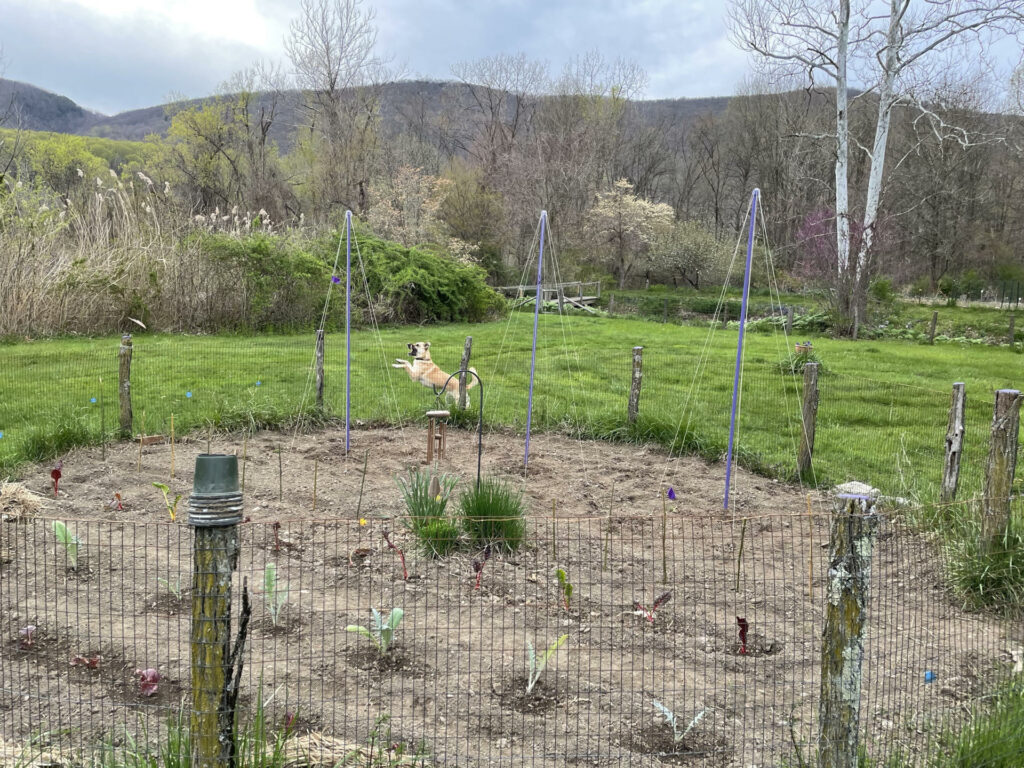
Other things to be on the lookout for?
Well, there are some types of nutrient deficiencies, like tomato blossom-end rot, where the end of the tomato will start rotting, it starts to turn black at the bottom, and that’s often associated with a deficiency in calcium. And then there are different kinds of fungal things that attack tomatoes, you have early blights and late blights, and you can get a lot of organic sprays that will address those issues. I just don’t like using sprays. Occasionally, when the caterpillar worm gets out of hand and I can’t keep up with it, I’ll use an organic spray called BT (Bacillus thuringlensis), which is a bacterium that, when it gets on the worm, sort of disintegrates the worm. But when it comes to bigger worms, like the tomato hornworm—they are the size of your thumb—I plant a lot of flowers in the garden as pollinators because I want to bring in good wasps and bees, and there’s a particular wasp that will lay its eggs on that tomato hornworm, and the eggs, when they hatch, will eat the worm….
Can you talk a bit more about planting for pollinators?
I put so many flowers in that garden, it’s like a row of vegetables, a row of flowers, a row of vegetables, a row of flowers. I have as many bugs as I can possibly attract, because there’s no way I am going to keep up with all of them, so I need good bugs, and in order to get them, you need to plant stuff that will be attractive them, and often the flowers will attract them. I love zinnia because, people don’t realize, you put the seed in the ground, and it grows into a beautiful plant that can be three or four feet tall that blooms beautifully and is so easy to grow. Some people wouldn’t think so because the flower can be so big! I plant a lot of different varieties of zinnia in the garden, in every color imaginable! I try to have as much variety and color as possible.
Do deer like zinnias?
Deer like everything, even the things they are not supposed to like. I have a single strand baited wire that’s electrified, two and a half feet off the ground. People, when they think of deer fencing, usually think six to eight feet tall, but this system is really ingenious, because I don’t like looking at fencing, and I certainly don’t want an eight-foot fence around 5,700 square feet of garden back there, and then to maintain fencing, it’s a job. This system is such that 2½ feet off the ground is kind of where the deer’s nose is always foraging, so it’s down, and there it is. They’ll find the wire because I’ll grease it with a little bit of peanut butter. So, it’s a single strand baited wire, and they’ll sniff the wire, or they’ll lick the wire, they’ll get a shock, and they never come back, and I swear they tell all their friends, I really do! So that’s something that is very important in this part of the world because the deer are prolific, they want to eat and, like us, they like variety!
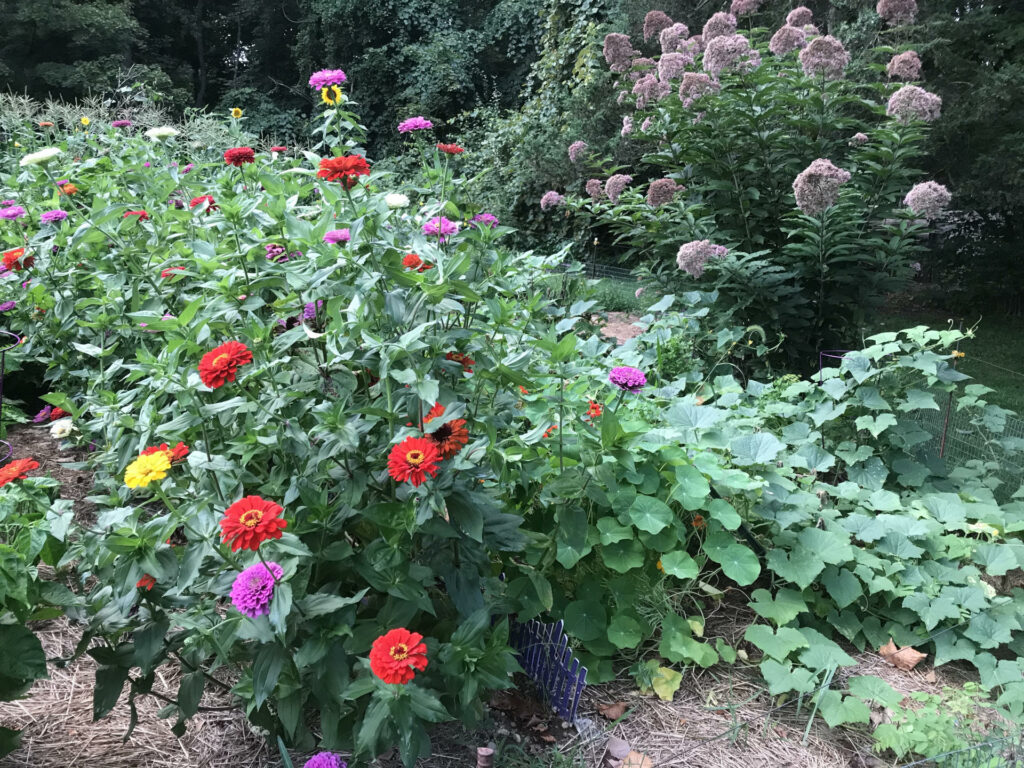
Have you found that certain species / varieties do well in your area and why do you think that is?
Well, the Butternut squash that we had. I plant lots of different winter squashes, but it’s the Butternut and the Long Island Cheese Pumpkin that survive. Every year I’ll plant at least four varieties, because I just can’t resist, and I think that the Butternut and Long Island are somehow able to resist the bug, which is a borer. It’s a bug that bores into the stem of the squash plants, lays its eggs, and after that there are all sort of worms in there. It’s always about laying eggs. The squash plant, the stalk itself, is hollow, so the borer bores into the center of the stalk and thinks it’s found a new home. How these animals know these things, I don’t know, but somehow, they know. For years I had a beautiful asparagus patch, and then I started getting the asparagus beetle, so sometimes it takes a while for the bug to find the plant that it really likes. Now that I have this asparagus beetle, I am fazing out the asparagus patch, and I planted some asparagus in this little peace pole garden, which is doing beautifully. Either they haven’t found it yet, or because that garden is all wildflowers—echinacea, which is native, and black-eyed Susan—they kind of camouflage it. But lately I get the best asparagus out of that garden.
How can one support biodiversity in one’s garden?
Plant as many varieties of vegetables and flowers, that’s really all it is. And you must give everything enough space to grow. I’m learning—over the years I’ve gotten better at it, because I used to grow very close. Even though I have a huge garden, I used to plant everything very close, because you have this tiny seedling. So, over the years I’ve just learned, this plant needs three feet by three feet, so measure the three feet, although you can plant very intensively. My cousin has a very small garden, she lives in Westchester, and she’ll grow forty tomato plants in a tiny little garden. I have a huge garden and I put up two 25-foot trellises, and I only plant eight tomato plants on one 25-foot trellis. Her plants tend to grow very tall and spindly, because they’re trying to get to the sun and they’re being shaded out by their neighbors, so they’re growing as tall and as fast as they can, racing after the sun. Plants adapt.
Any tips on dealing with critters like moles and voles?
I have a problem with moles and voles because I give them a really good environment. I mulch with a layer of newspaper and hay, so they can kind of walk underneath all that, they don’t even need to dig all that much. So, I noticed over the years I’ve gotten more moles and voles and they destroy everything from underneath. Now what I hope for are predatorial birds, like owls, and I have an owl box in the woods. People can put up things like a nesting box to attract them, and the more food sources there are, the more animals come in.
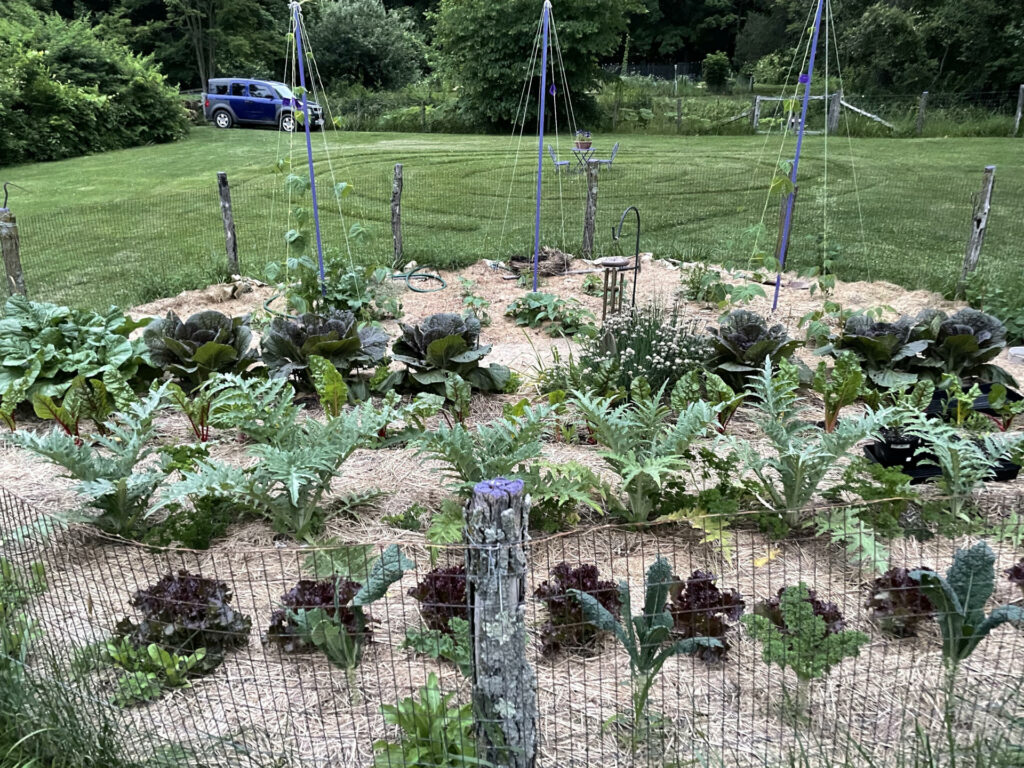
What about poison ivy?
Really the only way to get rid of it is to pull it out. When I see it in the garden, that’s what I do. Otherwise, there is poison ivy everywhere, and I just clip it back, it’s so established. Sometimes, if I see that hairy vine going up a tree, I’ll cut it at the base, but that just means that the vine will start spreading out. But with one of these invasive plants, Japanese Knotweed, I saw a patch, and thought, I’ve got to get rid of it, so I dug it up, and the next year it came right back, as if I’d done nothing. The following year I cut it and put a few drops of peppermint essential oil on the stem as close to the ground as I could, and it didn’t like it. I’ve used peppermint oil in the garden to detract the moles and voles, because a lot of animals don’t really like peppermint oil. But one year I overdid it and I killed all the stuff that I was growing, and when I saw that I thought, hmmm, peppermint kills. So now I order peppermint oil in big containers, pour it into smaller bottles and carry around a dropper, and drop it onto cut stems of things I don’t want to grow. It was a totally accidental discovery.
Do you compost?
I used to compost before I got chickens. Now the chickens compost for me. I put all my food scraps into the chicken yard, and they turn it over for me. So, I don’t have to compost anymore. I go and dig up the dirt in their yard and it’s black and beautiful. If you’re thinking of getting chickens, I think to be fair to them, you need to have at least four, because they are a flock animal, so you don’t really want to have just one or two. I think four is a good number to start, and no rooster, unless you want to hatch out your own birds. But you can get birds anywhere in the United States, so you don’t really need to do that.
What about watering?
Well, as I said, I mulch with newspaper and hay to retard weed growth and to maintain moisture, so I find I really don’t have to water that much. Last year we were in a drought, we didn’t have rain for two months, so I did a little bit of watering—if I had done more, my plants probably would have been a little happier. I water when I first transplant something into the ground, because it needs to maintain moisture, and then I do very little. If I see something that looks like it needs water, I’ll water it, but it’s all hand watering. Last year the extreme conditions made me think about doing some sprinkler watering, and I have a sprinkler that I can use. But if you think about it, what we call a good rain is when it rains all day, so a sprinkler, when you think of a rainfall…. But even last year I didn’t use that much water.
Anything else to share?
Every year I have an experiment crop, I grow something I’ve never grown before. I love eating out of my back yard—living off the land is what I’ve always liked to do—but, really, my passion is watching something grow, and when I’ve never seen something grow, I’m like, how does that grow? Last year it was oats, how do oats grow? I had about a fifteen-foot row, and it’s a beautiful plant, but of course the squirrels figured that out, so the squirrels attacked my oats before I got to eat one.
Any special recipes that you grow for?
Well, the Butternut squash soup, it’s not a special recipe, it’s just whatever I throw in the blender with the roasted squash. I am a very basic cook, I can cook anything, but I’m not a gourmet cook. I like to eat a lot of greens so kale salad to me is like heaven. I have a kale salad that I make with the corn that I grow. I cut up the kale really fine and I put in the corn and dress it with lemon and lime. One year I had nine different varieties of kale.
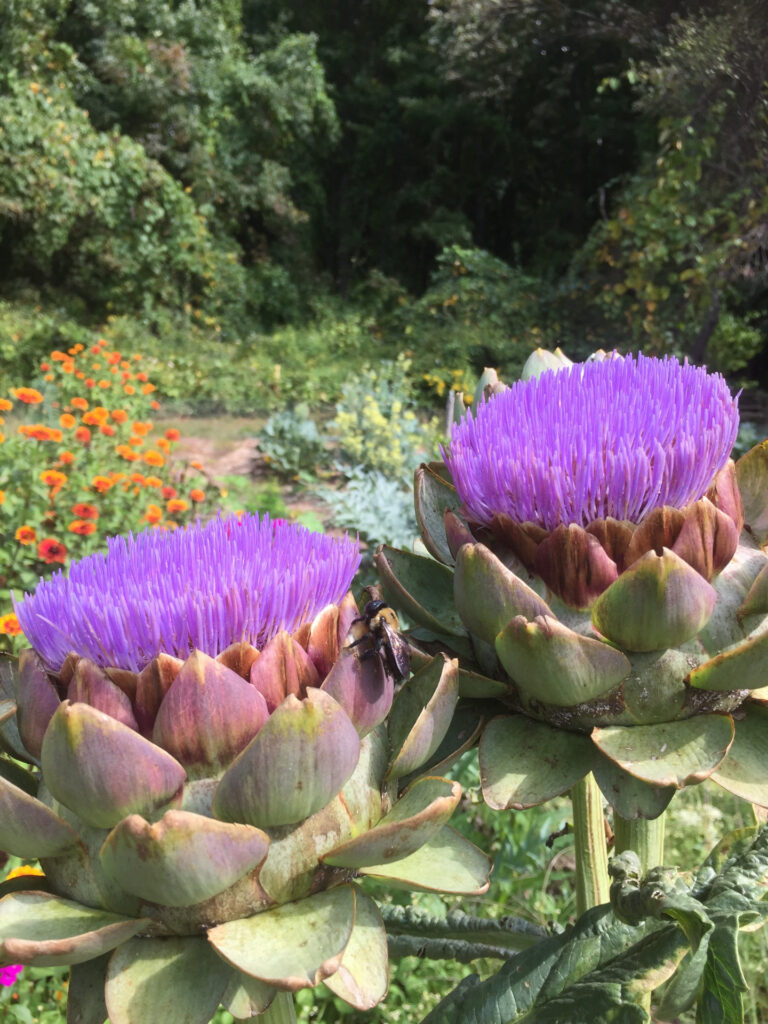
Any tips for people?
Just do it. The way I’ve learned is by doing it. I’m not a book learner, I’m an experiential learner, and because I’m so fascinated by growth habits and germination, when I see a seed pop through the ground, it’s so exciting! So basically, what I do is I just do! I’m constantly experimenting, because I don’t know what’s going to happen, so why not just try it and see what happens? I’m really a Let’s see what happens kind of person, and that’s how I’ve done the whole garden—let’s plant it this way this year and see what happens!
Final musings?
You know, a garden is the most unnatural thing there is, because in the natural world, plants grow where they grow, where they like growing. They find a place, or a bird drops a seed somewhere, or a root takes hold somewhere. It finds where it likes to grow and it grows there. In a garden, you’re saying: I’m going to put you there and now you are going to grow. And the plant is saying: well, I don’t really like it here, so I’m going to do what I’m going to do, but am I going to thrive here? Maybe not! So gardening is really a very unnatural thing to do, and you sort of have to recognize that going into it. I used to, in the very beginning, say: well, let’s see what happens if I throw some seeds over here, and throw some seeds over there… but it doesn’t work. You don’t take a handful of seeds in nature—I mean, you can broadcast things wildly, and maybe one in those 500 seeds will germinate, but I really think in gardening you have to be OK with trial and error. You have to spend time looking at what’s happening and try to encourage growth. Using your eyes in the garden is important, and spending time—it’s really about spending time. The more time you spend somewhere, the more you see. But you’re never going to be able to control it entirely.
(January 27, 2023)
Véronique Firkusny is a literary translator as well as a diction coach for singers and serves as the Executive Director of the Avery Fisher Artist Program. She is on WS/C’s Advisory Board.
Plantings
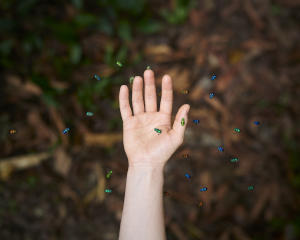
Ecological Kinship Makes Scents
By Jake Eshelman

Edwina von Gal on Ecological Action and Habitat Restoration
By Gayil Nalls

Energy is a Form Giver
A Conversation with R. Randall Vosbeck, FAIA
By Liz Macklin
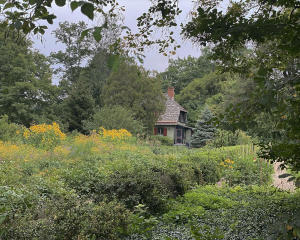
Samuel Morse
Locust Grove Estate and Nature Preserve
By Gayil Nalls
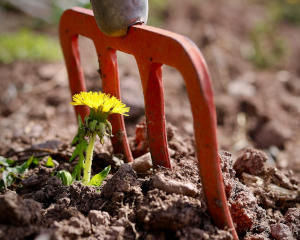
The Power of Weeds to End Hunger in an Uncertain Climate
By Lewis Ziska
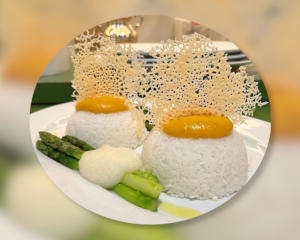
Eat More Plants Recipes:
Basmati Rice with Pumpkin, Asparagus, Cauliflower and Grana Padano ‘Waffle’
By Chef Giovanni Parlati

As Ireland transitions from the rich, smoky scent of peat-burning to a more sustainable future, its olfactory heritage is evolving. What will become the next iconic aromatic symbol of Ireland?
Click to watch the documentary trailer.


